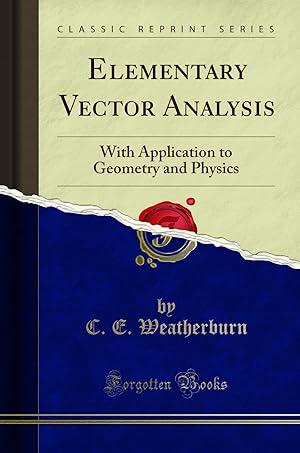Synopsis
Excerpt from Elementary Vector Analysis
The son gave early evidence of genius, being a remarkable linguist and displaying great mathematical talent. He entered Trinity College, Dublin, in 1824, where he had a brilliant and unprecedented career. His ability was so conspicuous that in 1827, while still an undergraduate, he was asked to apply for the vacant Andrews' Professorship of Astronomy in the Uni versity of Dublin, and was appointed to the position. He was not specially qualified as a practical astronomer; but the con ditions of his appointment allowed him to advance the cause of Science in the way he felt best able to do so. In 1835, while acting as secretary to the at its meeting in Dublin, he received a knighthood; and two years later the importance of his scientific work was recognised by his election as President of the Royal Irish Academy. His mathematical work continued uninterrupted till his death on 2nd September, 1865, at the age of sixty. It often happens that we get our most important ideas while not formally working at a subject, perhaps while walking in the country or by the sea, or even in more commonplace surroundings. From a letter of Hamilton's we learn that, on l6th October, 1843, while he was walking beside the Royal Canal on his way to preside at a meeting of the Academy, the thought flashed into his mind which gave the key to a problem that had been occupying his thoughts, and led to the birth and development of the subject of Quaternions. He announced the discovery at that meeting of the Academy, and asked per mission to read a paper on quaternions at the next, which he. Did on 13th November. During the next few years he expanded the subject, and published his Lectures on Quaternions in 1853, while the Elements of Quaternions appeared in 1866, soon after his death.
Présentation de l'éditeur
My object in writing this book was to provide a simple exposition of elementary Vector A nalysis, and to show how it may be employed with advantage in Geometry and Mechanics. It was thought unnecessary, in the present volume, to enter upon the more advanced parts of the subject, built upon the ideas of gradient, curl and divergence. Vector algebra and the differentiation of vectors with respect to one scalar variable furnish a powerful instrument even for the higher parts of dynamics. The work does not claim to be a complete text-book in either Geometry or Mechanics, though a good deal of ground is covered in both subjects. The use of vector analysis in the former is abundantly illustrated by the treatment of the straight hne, the plane, the sphere and the twisted curve, which are dealt with as fully as in most elementary books, and a good deal more concisely. In Mechanics I have explained and proved all the important elementary principles. The equations of equilibrium for a rigid body are deduced from the equations of motion. This is contrary to the ordinary practice and, of course, is not recommended for young beginners. But for a student who is able to read this volume, it is certainly desirable to show that the principles of statics are only particular cases of the dynamical ones, and that the long line of argument followed by text-books in Statics, to prove the theorems about moments, parallel forces, couples and the equilibrium of bodies, is really unnecessary. All these theorems are immediately deducible from the equations of motion of a rigid body, as shown in Chapter VIII. A nother departure from the ordinary practice has been made in connection with the theory of centroids.
(Typographical errors above are due to OCR software and don't occur in the book.)
About the Publisher
Forgotten Books is a publisher of historical writings, such as: Philosophy, Classics, Science, Religion, History, Folk
Les informations fournies dans la section « A propos du livre » peuvent faire référence à une autre édition de ce titre.

